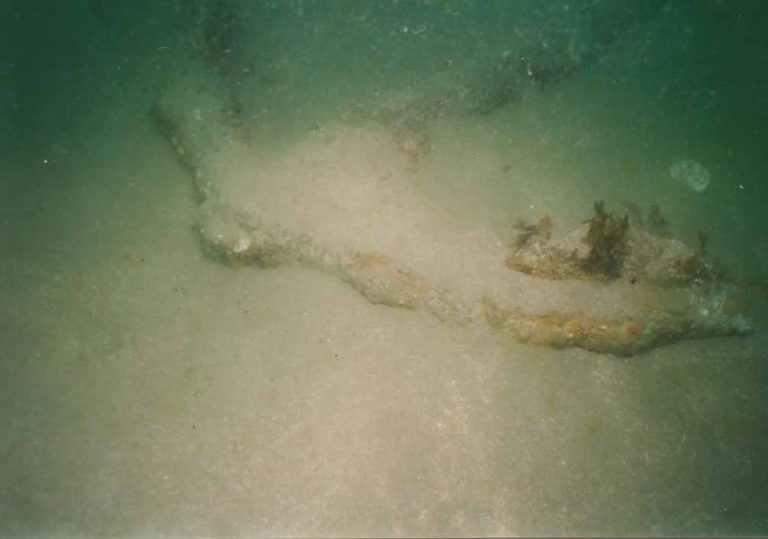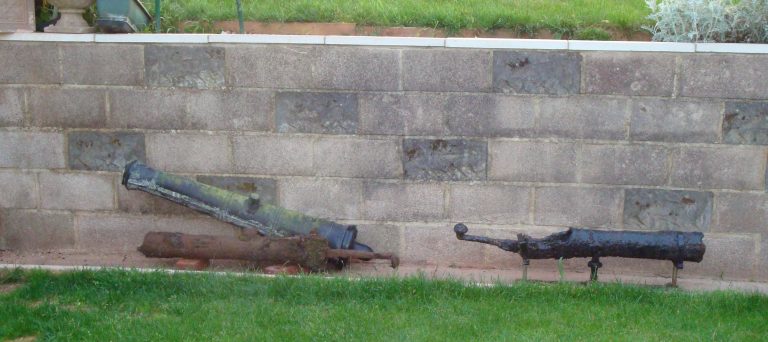Erme Estuary wrecks
N50 18.193 W3 57.480
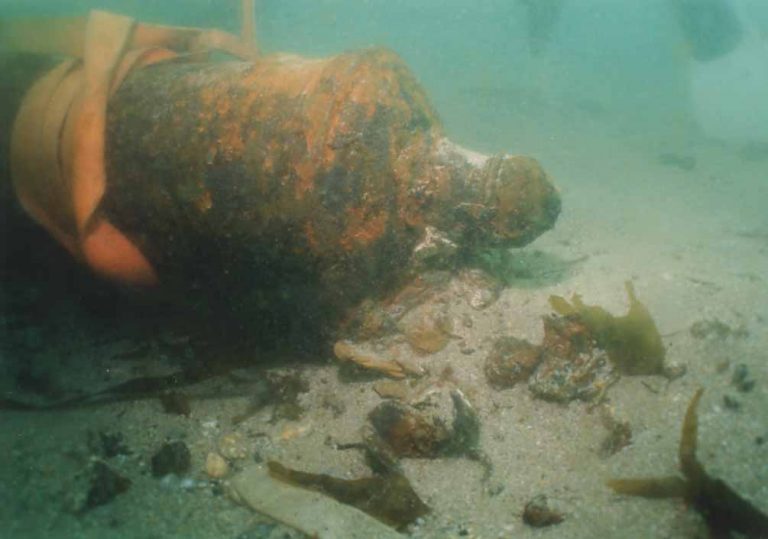
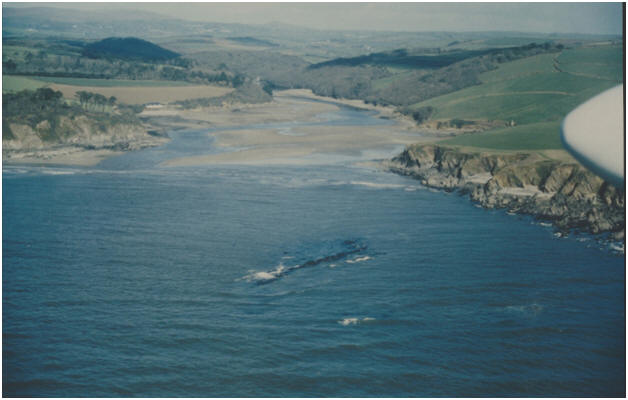
The river Erme in South Devon is tidal up to 3.5 miles from its entrance where it continues upstream to its source on Dartmoor . This route takes it past some of the best archaeological remains on the moor which suggest the estuary was used for trading via the sea during the bronze age. Over the years it has become a graveyard for ships as, from the sea, it looks like a save place to take anchorage but the underwater ‘Mary’s’ reef make the entrance a hazard for shipping.
The site was found by Stephen George who was snorkelling in the area in 1990 and found a swivel gun and cannon and in 1991 42 tin ingots were found in the mouth of the estuary on the north side of the West Mary Reef. Stephen was part of the Bigbury bay investigation Team who formed up with a group of divers from Northampton to form the South West Maritime Archaeological Group (SWMAG). This group did a comprehensive archaeological survey of the site in the 1990’s. These ingots date from around 1000 BC confirming that tin mining / trade was a major part of the South Devon economy throughout its history. These ingots are very similar to the ones found by the SWMAG team on the Moorssands site off Salcombe. Over 13 ships have are know to have been lost in the area ranging from 1000BC to 1793. The bronze age finds suggest early bronze age ships were lost in the area.
Erme Estuary Cannon site (This is an English Heritage protected site and the current licensee is (Dave Parham)
The Erme Estuary Cannon site lies in 4-8 m of water within a 250m radius of position 50° 18.41′ N, 03° 57.19′ W in a partially sheltered location adjacent to West Mary’s Rock at the mouth of Erme Estuary.

One of the wrecks found is thought to be a French armed merchantman. It may well have been the ship carrying Philip I of Castile and Joanna of Aragon who were rushing back to Spain to claim the throne of Castile when their fleet were wrecked in the area. The painting above give you some idea of what she may have looked like
The following sketch shows the layout of the artefacts found. One of the ‘Finbanker’ cannons (1630/1650 )and a swivel gun have been raised and the cannon is now on display on the quay at Hope Cove in South Devon, having been resorted and mounted on a replica carriage. The sketch below shows the layout of the site of the shipwreck.

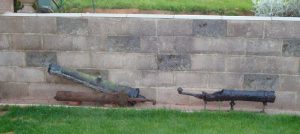
The following magnetometer survey was carried out by Pete Holt (Sonardyne Ltd) in the 1990’s ,on behalf of the South West Maritime Archaeology Group. The cluster of hits adjacent to Redcove Point are the cannon believed to be from a French ship of 1506
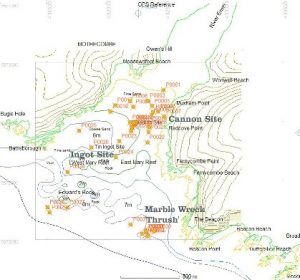
Photo’s below show Dave Illingworth making the carriage for the cannon.

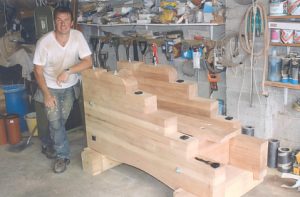
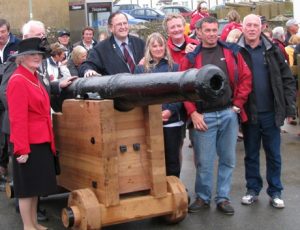

The above picture shows some members of the SWMAG team ( Neville Oldham, Mike Williams, Ron Howell Julie Williams, Dave Illingworth ) transferring the cannon to its new home on the quay at Hope Cove.
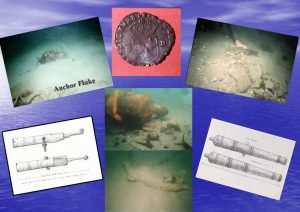 When first recovered it was thought the cannon had come from a wreck of 1506 as the divers had first raised a small swivel gun which Colin Carpenter ‘’One of the countries leading experts of ancient Ordinance’’ date d as1500. This had fitted in with account by Leyland a diarist and chronicler for Henry VIII who in his account of the area stated that Philip Archduke of Flanders and Joanne of Aragon in 1506 on their way back to claim the throne of Aragon had suffered being ship- wrecked in this haven, which had always been thought to be the Erme. The group had been excited at this information. When a larger cannon was recovered and dated as 1630/1680 and was a Finbanker type of cannon it confused the picture. When the account of another diarist Triston Risdon who rode through Devon in 1700 stated that there had been a great shipwreck in the Erme on the 13November1632 but unfortunately did not give a name. The team also found a French Silver Half-Ecu coin that would point to the shipwreck being French.Below is a montage of some of the other artefacts found on the site:
When first recovered it was thought the cannon had come from a wreck of 1506 as the divers had first raised a small swivel gun which Colin Carpenter ‘’One of the countries leading experts of ancient Ordinance’’ date d as1500. This had fitted in with account by Leyland a diarist and chronicler for Henry VIII who in his account of the area stated that Philip Archduke of Flanders and Joanne of Aragon in 1506 on their way back to claim the throne of Aragon had suffered being ship- wrecked in this haven, which had always been thought to be the Erme. The group had been excited at this information. When a larger cannon was recovered and dated as 1630/1680 and was a Finbanker type of cannon it confused the picture. When the account of another diarist Triston Risdon who rode through Devon in 1700 stated that there had been a great shipwreck in the Erme on the 13November1632 but unfortunately did not give a name. The team also found a French Silver Half-Ecu coin that would point to the shipwreck being French.Below is a montage of some of the other artefacts found on the site:
Ingot site (Also and English Heritage protected site)
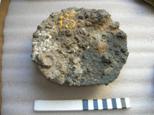 The Erme Estuary Ingot site lies in 6-10m of water within a 100m radius of position 50° 18.15′ N, 03° 57.41′ W in an exposed location adjacent to West Mary’s Rock at the mouth of Erme Estuary
The Erme Estuary Ingot site lies in 6-10m of water within a 100m radius of position 50° 18.15′ N, 03° 57.41′ W in an exposed location adjacent to West Mary’s Rock at the mouth of Erme Estuary
The older Bronze Age site has revealed Tin Ingots from around 1000BC. These are currently on display at the Exeter Museum.
Following archaeological recording, a total of 44 ingots have been recovered from the site by the South West Maritime Archaeological Group. The collection consists of heavy abraded crude tin ingots ranging in form and weight, the largest weighing 12.95kg and the smallest 0.256kg, most are less than 1.5kg. Forms present include round and oval with two ‘H’ shapes. These forms are similar to ingots found elsewhere on both Iron Age (eg Castle Dore and Chun Castle) and early medieval sites (notably at Par Beach, St. Martins Scilly, Trethurgy, St Austell and Praa Sands) in the south-west. The origins of the ingots are a subject of much discussion but are likely to have been Devon or Cornwall, both major sources of tin, and the varying sizes and forms of the ingots may be indicative of a cargo of material brought from a variety of locations for transit. Early medieval imported Mediterranean pottery found in south west and Irish Sea has been linked to tin export from the south west, and has been found close to the wreck site at Mothercombe, which may provide a date for the wreck. Alternatively the two small ‘H’ shape ingots have been compared to Diodorus 1st century BC reference to the astragali shaped tin ingots produced by the inhabitants of south west Britain, which if correct would give them an Iron Age date.
Known losses of ships in the area are:
‘Mad Joanna’s wreck’ A fleet of 300 ships taking Phillip of Castile and his wife Joanna from Antwerp to Castile to claim his throne are caught in a storm and dispersed along the English Channel. Severn of these seek shelter at Dartmouth, some are wrecked at Melcombe and two between Dartmouth & Plymouth Two of the above fleet are lost at the mouth of the Erme and there are references to Phillip being wrecked in the Erme estuary | January 1506 | |
| Unknown significant wreck | 13th January 1632 | |
| French Ship | 20th February 1637 | |
| Genoese ship | 21st February 1668 | |
| Dutch ship | 29th November 1691 | |
| French ship | 1st February 1695 | |
| Unidentified ship | December 1698 | |
| ‘Rochester’ | December 1698 | |
| HMS Pygmy | 15th December 1793 | |
| St John Baptista | 1795 | |
| Caroline | December 1851 | |
| Commerce De paris | 1869 |
